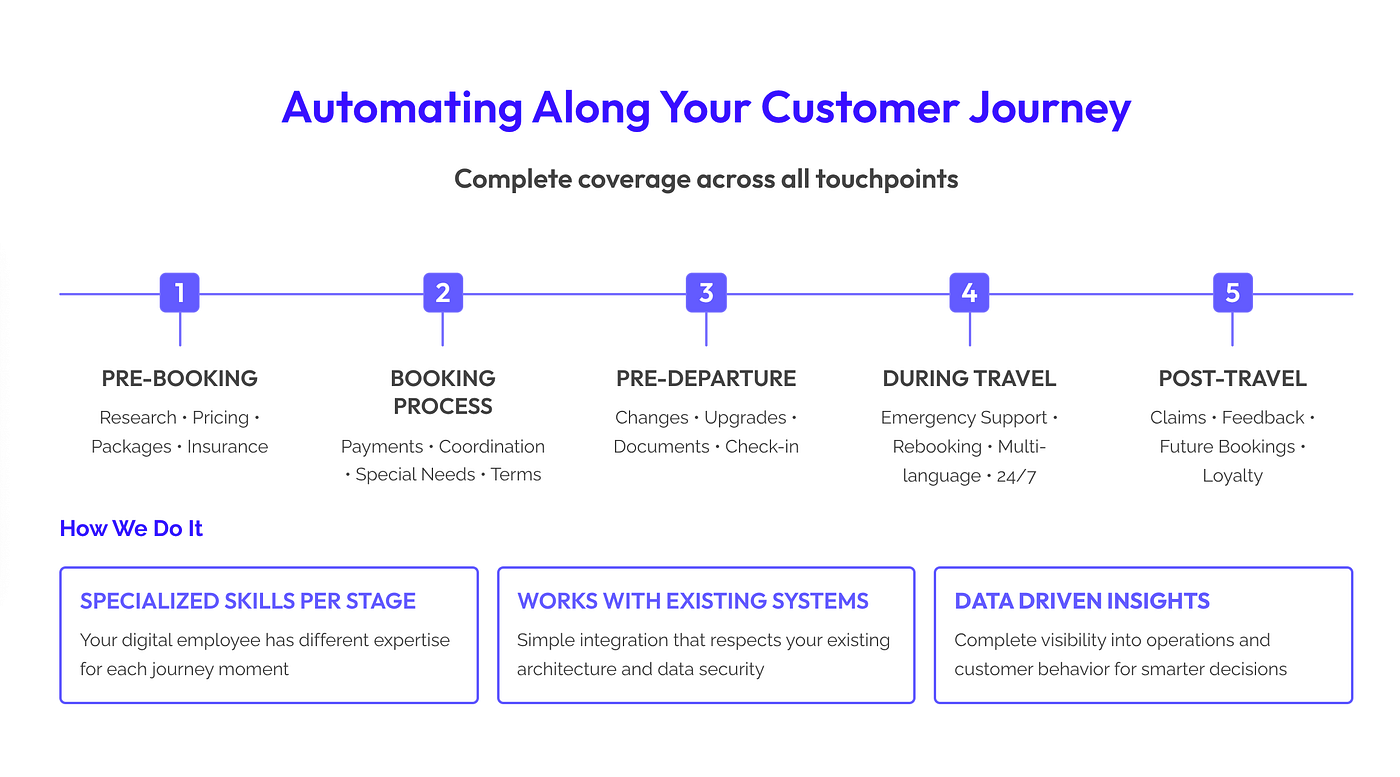.jpg)
On the front lines of AI implementation, I’ve seen firsthand what separates successful, high-impact initiatives from the ones that fail. The difference is rarely the technology; it’s the approach. Too often, I see travel companies implement AI solutions without a proper overarching, client-centric structure.
While starting with a single, focused AI agent is an understandable first step, without a shared blueprint it leads to problems. Different departments inevitably begin launching their own separate initiatives. This results in an inefficient implementation with duplicated development efforts and knowledge that remains isolated within one team. More importantly, it creates a frustrating and disconnected experience for the customer, as they are forced to interact with digital colleagues who work in silos.
This brings us to the bigger picture. The true vision isn’t a collection of disparate employees; it’s the creation of fully functional digital workforce, AI colleagues you can chat, mail, and call with, deeply integrated into your backend systems and empowered to take real action.
And to get there, using the customer journey as your blueprint is really important. It is the only way to ensure every small, pragmatic step contributes to a single, powerful, and cohesive system.
So, how do we begin building that cohesive system? With a customer journey map. At Freeday, this isn’t a theoretical exercise; it’s one of our core principles (we like to work from principles).
At its core, in travel, the journey can be broken down into five distinct operational stages:

Understanding these stages in depth is the first step. The strategic power, however, comes from designing a digital workforce that can maintain one continuous, omnichannel conversation across all of them. This is where you unlock transformative value.
For example, when a traveler from the pre-booking stage asks an FAQ-style question during the booking process, your digital employee knows the exact destinations they were inspired by. The answer isn’t generic; it’s contextual. “Yes, the cancellation policy for that specific Costa Rica eco-lodge is fully flexible.”
This continuous memory allows the digital employee to become a proactive assistant. while in the pre-departure stage, it can message the traveler: “Hi, just a reminder your flight to Costa Rica leaves tomorrow. Would you like me to check you in?” This is the crucial shift from a reactive tool to a valuable, proactive colleague.
The conversation is no longer trapped in a single channel. A traveler can start a query by calling, then have the details sent seamlessly to WhatsApp to complete at their leisure. The context is never lost. By using the journey as our strategic map, we ensure our digital workforce can do what disconnected agents never can: maintain one continuous, intelligent conversation with the customer, wherever they are.
So how to begin? With the customer map understood, you need a pragmatic plan to build your workforce. This three-step playbook shows how to put the journey-first principle into practice, starting with a single hire and expanding intelligently.
Step 1: The Pragmatic First Hire We begin by targeting the point of greatest friction and volume, typically in the Pre-departure and During travel stages. We onboard a Digital Employee for the customer service team with a foundational FAQ Skill. This delivers an immediate, measurable win by freeing up human agents. This is not an isolated fix; it is the first building block of the system.
Step 2: The Strategic Expansion Here, the principle demonstrates its economic power. We onboard the same Digital Employee for the marketing and sales teams, adding an Planning and Research Skill and a Booking Skill. When a customer asks a general question, we don’t build a new function; we reuse the exact same FAQ Skill perfected by the service team. Instead of rebuilding, you reuse and strengthen the core system, ensuring consistency and maximizing your return on investment.
Step 3: Compounding Value The true power emerges when the digital and human workforces synchronize. Imagine an offline retail agent leading an inspirational conversation while the Digital Employee works as a co-pilot, handling all administration. Online, the roles are reversed. The Digital Employee leverages the same flows and skills to guide a customer from inspiration to booking. This synergy creates an intelligent, reusable asset that delivers compounding value across your entire organization.
The path to integrating AI is at a fork in the road. One path, launching disconnected, task-based agents, is a short-term tactic that leads to the long-term fragmentation and frustration we described at the start.
The alternative is a strategic shift, grounded in the powerful principle that the customer journey must be the central blueprint for your digital workforce.
This approach is a practical plan for success that:
Ultimately, the goal is to move beyond simply buying AI tools and toward building a durable, intelligent asset for your organization. By grounding your strategy in the customer journey, you ensure you are not just launching another project but are onboarding the foundation of a workforce that will grow, learn, and deliver value for years to come.